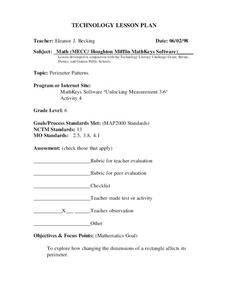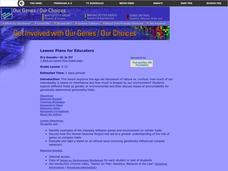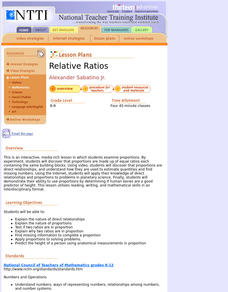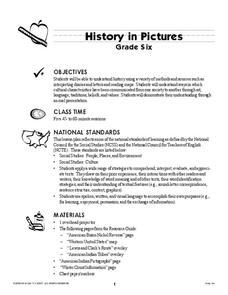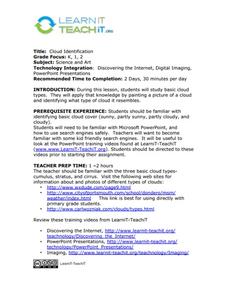Curated OER
Physical or Chemical? That Is the Question
Young scholars find examples of physical and chemical changes using the five Web World Wonders camera sites.
Curated OER
Bats
Third graders replace a common KWL with an anticipation activity. In this bats lesson, 3rd graders use radio buttons to record their answers to questions at the beginning of a bat lesson. Students view a website to read about bats and...
Curated OER
One Size Fits All?
Students describe the differences between an estimate and a guess. They create reasonable estimates based on comparison and activities. Students explain how estimation is helpful in showing the relative size on a scale. They also...
Curated OER
Area: It's What's on the INSIDE That Counts!
Second graders participate in a series of hands-on, online and multimedia activities that examine the concept of area. They view clips from the animated series Math Monsters and discuss the purpose of area and how it is used in the real...
Curated OER
THE TRAVELS OF BABAR: An Adventure in Scale:Conflict Resolution an Safety
Students research new techniques to solving conflicts without violence. Many new vocabulary words are uncovered within this lesson. They discuss Jean de Brunhoff's The Travels of Babar as an example of how a conflict can be resolved in a...
Curated OER
Perimeter Patterns
Sixth graders calculate perimeter of rectangles with different dimensions. In this perimeter lesson, 6th graders define length, width and perimeter. Students complete a perimeter activity using a web tool to change the dimensions of...
Curated OER
Rain Forests
Middle schoolers investigate claims of medicinal plants found in the rain forest. In this research skills lesson, students examine the validity of Internet sources as they visit websites in search of information about rain forest plants...
Curated OER
When Clay speaks
Learners listen as the teacher reads "When Clay Sings," by Byrd Taylor. They discuss clay, and view a variety of clay items. Students watch a video clip "Interests in One of a Kind Pots." They watch a demonstration on working with clay....
Curated OER
Hide In Plain Sight
Students view video clips and use the Internet to look for hidden animals. They then use the Internet to print out animal shapes and color them. They create environments on construction paper in which their animals can hide.
Curated OER
America's Favorite Landmarks
Students research using Google Earth a variety of websites to explore America's most prominent and famous buildings. They then compare and contrast architectural styles and write a position paper defending or arguing against their chosen...
Curated OER
Significant What?
High schoolers define accuracy and precision, and differentiate between the two terms, apply the concepts of accuracy and precision to a given situation and correctly apply the concept of significant figures to measurement and...
Curated OER
Healthy Eating
Students explore how they can make healthy food choices and assess how "eating healthy" requires knowledge and planning ahead. They review and discuss The Edible Pyramid as well before they complete this project online. Each student maps...
Curated OER
It's Genetic--Or Is It?
Students identify examples of the interplay between genes and environment on certain traits and discuss how the Human Genome Project has led to a greater understanding of the role of genes on complex traits.
Curated OER
Relative Ratios
Students discover that proportions are made up of equal ratios each containing the same building blocks. They, using the Internet, apply their knowledge of direct relationships and proportions to problems in planetary science.
Curated OER
GANDHI'S INDIA
Students describe key events in the life of Gandhi. They determine why knowledge of geography is necessary to understand the history of the people in a place or region. They write a summary of how the events in Gandhi's life,...
Curated OER
Dance: African Drumming
Students evaluate the messages in music. In this communication through music lesson, students listen to various musical selections and determine the message being conveyed in the song. Then, students create their own message as they...
Curated OER
The Appearance of a Graph
Sixth graders understand that the appearance and increment used on the x and y axis in a graph change how it looks. In this graphing lesson, 6th graders work in pairs and interpret graphs using different axes. Students collect graphs...
Curated OER
It's A Snap! (Place Value Made Easy)
Students are introduced to the importance of using place value in number systems. They view a video, play games, explore websites and research the pay scale of three jobs that interest them.
Curated OER
School Newspaper
Students investigate writing a school newspaper. In this writing a school newspaper lesson, students choose topics that will be included in the school newspaper. Students view online sites about writing articles and break into groups to...
Curated OER
A More Perfect Union: Women's Suffrage and the Constitution
Young scholars reflect on the pros and cons of Women's Suffrage and it was viewed during the late 1800's. In this history lesson, students will analyze documents on women's suffrage so that they can compare and contrast the rights of...
Curated OER
Making and Breaking the Grid
High schoolers examine the grid in terms of a method of organization in our society as well as graphic design. In this "Making and Breaking the Grid" lesson, students design solutions to common problems and draw conclusions about...
Curated OER
History In Pictures
Sixth graders explore Lewis and Clark's expeditions. In this Lewis and Clark lesson, 6th graders view the routes they took and discuss how the territory has changed. Students make a timeline of their journey. Students research online for...
Curated OER
The Grand Canyon
Students investigate how dams help and hurt the ecology of an area. In this Grand Canyon activity, students research the Glen Canyon Dam and why it flooded in 1996. Students create a pros and cons list about dams and write a summary.
Curated OER
Cloud Identification
Students study types of clouds. In this earth science lesson, students read the book The Cloud Book. Students use photos to examine each type of cloud and visit suggested websites.







